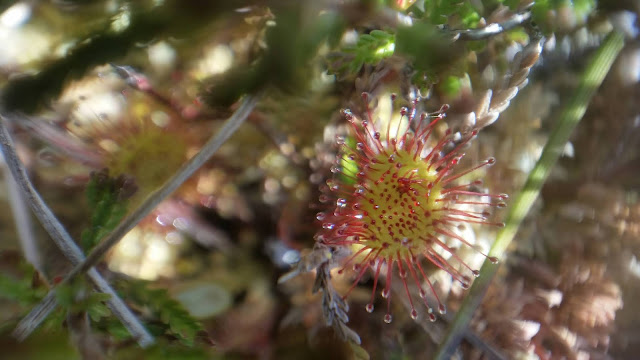Last week I joined some other keen botanists and went to Loch Vaa to look for some specific plants that are not found much locally. Ian Green, who is the BSBI recorder for vice-county 95 (Moray) led the walk as he knew what we were looking for, whereas the rest of us had not even heard of the plants!
Loch Vaa is North of Aviemore and is just behind Laggantygown Cemetery so there is convenient car parking. It was a stunningly sunny day and the loch was quite low, exposing a stony shore.
 |
| Loch Vaa |
The water was crystal clear and there were shoals of small fishes.
There were two plants that we were looking for, both related to a more common species. The first was a hybrid Spearwort. Lesser Spearwort (Ranunculus flammula) has a flower like a buttercup but grows in damp or wet areas and has thin leaves.
 |
| Lesser Spearwort with narrow leaves (the broad leaves belong to the pondweed) |
The plant we were looking for was a hybrid - a cross between Lesser Spearwort and Creeping Spearwort with the unwieldy name of Ranunculus x levenensis. But Creeping Spearwort is an extremely rare plant and does not grow in Moray. So how did the hybrid get here? The best explanation is that it was brought in on the feet of visiting waterfowl. As it roots readily from the stem, this would help it get established. We found quite a few plants but it is maybe not the most impressive sight .
 |
| Hybrid Spearwort |
In fact, most of the plants we concentrated on were rather small. The next on the list was Small Water-pepper (
Persicaria minor), which prefers to grow in more southerly areas and Loch Vaa is the farthest North that it has been found.
 |
| Small Water-pepper |
It is like Redshank (
Persicaria maculosa) which is much bigger and sometimes has a black blotch on the leaves. It is very common and I have seen it growing at the side of the pavement in Newtonmore Main Street. I was quite surprised to find I don't have a photo of it!
Another plant I had not seen before was Marsh Speedwell (
Veronica scutellata). This one had blue flowers but they can be pink or white.
 |
Marsh Speedwell
|
Inspired by the trip, I thought I would visit Lochain Uvie (just at the base of Creag Dubh) to see if I could find the same plants, as when the loch is low, there is a stony bit of shore.
 |
| Lochain Uvie looking West |
 |
| Lochain Uvie with Creag Dubh in the background. |
I did not find the two rarities as the stony bit was covered in grass. But there were other compensations. In a dried out boggy area I found a lot of Great Sundew (Drosera anglica). "Great " is a bit of an exaggeration as it is tiny! It is an insectivorous plant and catches insects on its sticky hairs. The leaves are longer and more spoonlike than its even smaller relative, Round-leaved Sundew (Drosera rotundifolia).
 |
| Great Sundew |
It does have flowers but they were still in bud.
Another bog plant had finished flowering but its seeds were a bright, bright orange.
 |
| Bog Asphodel |
And finally, there were plenty of grasshoppers pinging about when you walked through the grass. So a very pleasant trip even if I did not find the rarities.











.jpg)
























